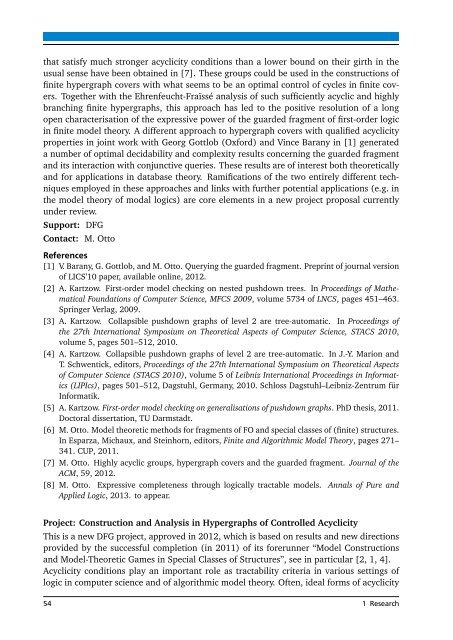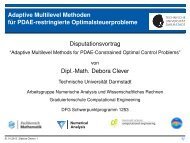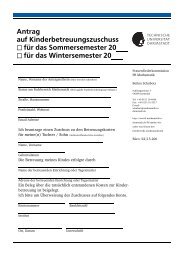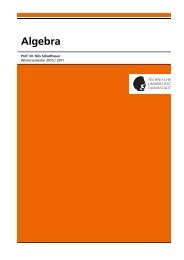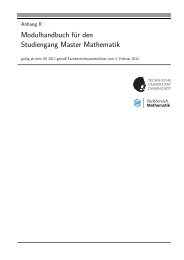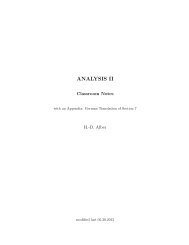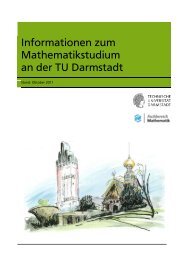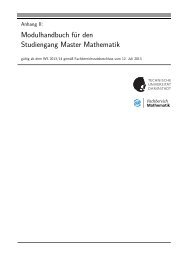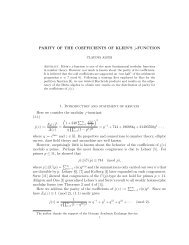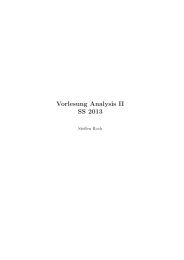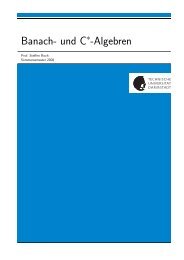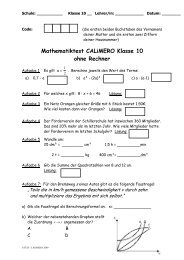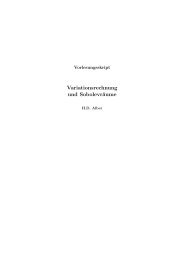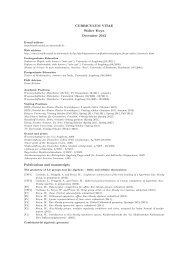Biannual Report - Fachbereich Mathematik - Technische Universität ...
Biannual Report - Fachbereich Mathematik - Technische Universität ...
Biannual Report - Fachbereich Mathematik - Technische Universität ...
You also want an ePaper? Increase the reach of your titles
YUMPU automatically turns print PDFs into web optimized ePapers that Google loves.
that satisfy much stronger acyclicity conditions than a lower bound on their girth in the<br />
usual sense have been obtained in [7]. These groups could be used in the constructions of<br />
finite hypergraph covers with what seems to be an optimal control of cycles in finite covers.<br />
Together with the Ehrenfeucht-Fraïssé analysis of such sufficiently acyclic and highly<br />
branching finite hypergraphs, this approach has led to the positive resolution of a long<br />
open characterisation of the expressive power of the guarded fragment of first-order logic<br />
in finite model theory. A different approach to hypergraph covers with qualified acyclicity<br />
properties in joint work with Georg Gottlob (Oxford) and Vince Barany in [1] generated<br />
a number of optimal decidability and complexity results concerning the guarded fragment<br />
and its interaction with conjunctive queries. These results are of interest both theoretically<br />
and for applications in database theory. Ramifications of the two entirely different techniques<br />
employed in these approaches and links with further potential applications (e.g. in<br />
the model theory of modal logics) are core elements in a new project proposal currently<br />
under review.<br />
Support: DFG<br />
Contact: M. Otto<br />
References<br />
[1] V. Barany, G. Gottlob, and M. Otto. Querying the guarded fragment. Preprint of journal version<br />
of LICS’10 paper, available online, 2012.<br />
[2] A. Kartzow. First-order model checking on nested pushdown trees. In Proceedings of Mathematical<br />
Foundations of Computer Science, MFCS 2009, volume 5734 of LNCS, pages 451–463.<br />
Springer Verlag, 2009.<br />
[3] A. Kartzow. Collapsible pushdown graphs of level 2 are tree-automatic. In Proceedings of<br />
the 27th International Symposium on Theoretical Aspects of Computer Science, STACS 2010,<br />
volume 5, pages 501–512, 2010.<br />
[4] A. Kartzow. Collapsible pushdown graphs of level 2 are tree-automatic. In J.-Y. Marion and<br />
T. Schwentick, editors, Proceedings of the 27th International Symposium on Theoretical Aspects<br />
of Computer Science (STACS 2010), volume 5 of Leibniz International Proceedings in Informatics<br />
(LIPIcs), pages 501–512, Dagstuhl, Germany, 2010. Schloss Dagstuhl–Leibniz-Zentrum für<br />
Informatik.<br />
[5] A. Kartzow. First-order model checking on generalisations of pushdown graphs. PhD thesis, 2011.<br />
Doctoral dissertation, TU Darmstadt.<br />
[6] M. Otto. Model theoretic methods for fragments of FO and special classes of (finite) structures.<br />
In Esparza, Michaux, and Steinhorn, editors, Finite and Algorithmic Model Theory, pages 271–<br />
341. CUP, 2011.<br />
[7] M. Otto. Highly acyclic groups, hypergraph covers and the guarded fragment. Journal of the<br />
ACM, 59, 2012.<br />
[8] M. Otto. Expressive completeness through logically tractable models. Annals of Pure and<br />
Applied Logic, 2013. to appear.<br />
Project: Construction and Analysis in Hypergraphs of Controlled Acyclicity<br />
This is a new DFG project, approved in 2012, which is based on results and new directions<br />
provided by the successful completion (in 2011) of its forerunner “Model Constructions<br />
and Model-Theoretic Games in Special Classes of Structures”, see in particular [2, 1, 4].<br />
Acyclicity conditions play an important role as tractability criteria in various settings of<br />
logic in computer science and of algorithmic model theory. Often, ideal forms of acyclicity<br />
54 1 Research


